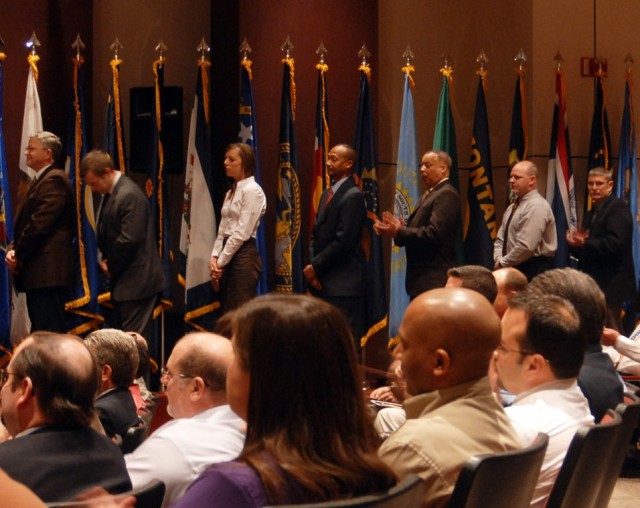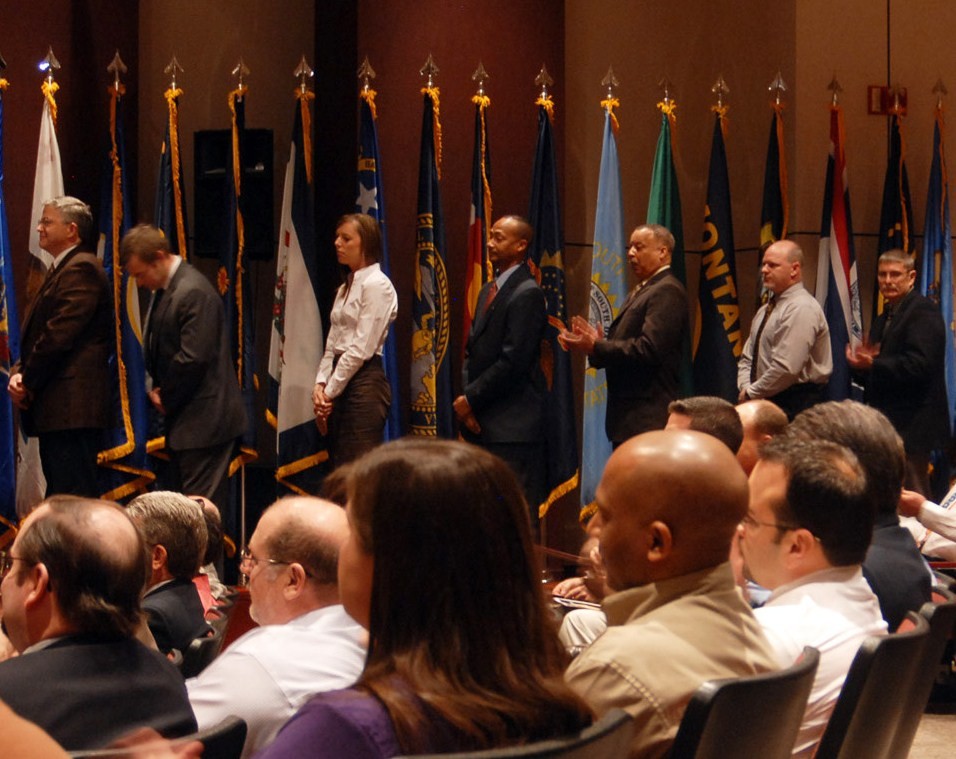REDSTONE ARSENAL, Ala. -- Recognizing employee performance is a "big deal" to the Aviation and Missile Command's Maj. Gen. Jim Rogers.
So, when it came to planning his first AMCOM deployed work force recognition ceremony, Rogers was right with the game plan.
On March 3, Rogers was able to express the Army's appreciation to a select group of more than 50 civilian and contract employees - with a few Soldiers sprinkled in the mix - who have recently returned from deployments in support of servicemembers in Iraq and Afghanistan. The Deployed Workforce Recognition Ceremony, held in Bob Jones Auditorium, was the sixth in a series, continuing a tradition started with previous AMCOM commanders.
"This is a big deal," Rogers said. "We never recognize people enough. And we always have to recognize those who take the extra effort.
"These employees deployed to serve our Soldiers and their families, and to be away from their own families so that we can get done what we need to get done to protect the United States of America."
One of those Rogers mentioned was Jim Higgins, an Integrated Materiel Management Center employee who has deployed five times to assist with equipment inventory and accountability.
"That's unbelievable," Rogers said. "The deal is we couldn't do it without you."
Higgins deployed the first time in the Global War on Terrorism in 2004 to Kuwait, and then in 2005 to Kuwait, 2007 to Mosul, Iraq, and 2009 to Kabul, Afghanistan. His last deployment in 2010 was to Iraq.
"I had 22 years in the military and it's in my blood, they tell me. I really do enjoy it," said Higgins, who also served three tours in Vietnam as a Soldier and retired from active duty as a first sergeant.
In stressing the importance of in-theater civilian and contractor support to the war fighter, Rogers mentioned the work he was involved in earlier in the morning to address real-time aviation challenges that had arisen.
"There were civilians on the ground who knew exactly what was going on and told us what we need to do to fix it," he said.
He also talked about the recognition Soldiers often receive when wearing their uniform in public, especially at airports. While those uniforms often draw "thank yous" from the general public, civilians who have deployed are overlooked because they don't look like Soldiers.
"We want to recognize the successes of your deployments," he said. "There are a lot of you who wear civilian clothes that don't get the privilege of hearing 'thank you.' So, we want to say 'thank you' from the Army, AMC and AMCOM. We appreciate the sacrifices that you and your families made when you deployed."
Higgins, 62, knows what those sacrifices are all about. During his fifth deployment, he was injured by a car bomb that exploded into a mushroom cloud near the fenced border of an Iraqi airstrip near the Pakistani border in the early morning hours of June 29, 2010.
The force of the explosion threw Higgins to the ground. Once he got back up, Higgins was surprised to find himself a target of the enemy.
"Eight of them were on the airfield and they were aiming right at me," he recalled. "The bullets were pinging, and the pinging reminded me of Vietnam. I was unarmed, so I ran back into the passenger terminal, and then there was a 30-minute firefight between them and the Soldiers at the terminal. A helicopter came in and killed all eight."
It wasn't long before Higgins started feeling the effects of that incident. He began stumbling frequently and he noticed short-term memory loss.
"I didn't want to tell anybody," he said. "I didn't want to get anyone involved. It was 'eat it up and keep going.'"
Higgins went on to complete his deployment, returning to the U.S. at the end of September. He is now undergoing cognitive testing at the VA Hospital in Birmingham.
"This wasn't the first time for something like this to happen. I've seen all kinds of things during my deployments," he said. "In Mosul, when we'd have rocket attacks, while everyone was running to the bunker, I'd go out and watch. I know I did dangerous things."
Higgins worries that his injuries will lead to poor performance in his job now that he is working in the inventory branch at the IMMC offices at the Sparkman Center.
"I want to do a good job. I feel bad that maybe my problems are causing me not to do the kind of job I want to do," he said.
Despite the cost to his physical health, Higgins is proud of his service.
"I enjoyed the responsibility and the Soldiers I worked with," he said. "The more responsibility they gave me the more I enjoyed the decision making process."
Higgins is especially proud of the inventory accountability procedures he helped establish and that are still being used in theater today.
"I was the responsible officer for theater-provided equipment. I had $5 billion worth of equipment that I had to keep inventoried," he said. "When units came in, we had the equipment ready for them."
Higgins worked to establish an inventory system that required units to submit monthly reports of equipment on hand. The reports are important for accountability as equipment is often moved from one unit to another to meet specific needs.
"There were 400 units in Bagram and there was always 40 to 45 company commanders out of that 400 who would not turn their reports in. That was a problem because there were a lot of lateral transfers of equipment and if the reports weren't turned in then we wouldn't know where the equipment was," Higgins said.
"So, if we didn't get a valid accounting of equipment every month from a unit then we would freeze transfers of equipment in and out of that unit, except if it involved life support or arms for the Soldier. By doing that, company commanders got their inventory reports in every month, and the accuracy and accountability became much, much better."
The ability to contribute and make a difference for Soldiers is often the reason civilians and contractors decide to volunteer for deployment.
Walter Nettles and his co-worker Kenneth Burt have each deployed four times opposite each other, working much like a tag team in providing support as the logistics lead for the C-RAM program. Since 2005, they each have deployed three times to Iraq and once to Afghanistan.
"We established the logistics footprint, served as the liaison for the major Army commands and served as the contracting officer representative," Nettles said.
Though recognized at the deployed work force ceremony, Burt was not present to receive his certificate due to his current deployment. His wife, Mary White-Burt, stood in his place for the ceremony.
"Both of us were used to deploying because we are previous military," Nettles said. "The war fighter and the civilian side of the house are different. But, when we are deployed, we work in the same conditions. We work side-by-side and hand-in-hand."
Both Nettles' and Burt's wives are also prior military and are familiar with how to live with the sacrifices of deployments.
"We kind of adapt and overcome. It doesn't get any easier. It really gets harder with each deployment," Mary White-Burt said. "But we understand it's for a greater cause and for building a better place for all of us."
Nettles said he would encourage other civilians and contractors to consider serving in a deployment.
"This is for someone who wants to get experience and knowledge firsthand. It is definitely a good learning experience," he said.
The following employees received the Global War on Terrorism Medal at the Deployed Workforce Recognition Ceremony:
IMMC - Norman Curry, Walton Walls and Roosevelt Rushton
AMCOM - Brittany Sikes and Renee Campbell
USATA - Bradley Fulton, Gilbert Atwood and William Gannon
AMRDEC - Kenneth Wegrzyn and Kirk Smith
PEO Missiles and Space - Brad Schroeder and Dru Jackson
LOGSA - Judith Mayhem, Rodney Steele and Paul Prichard
MSIC - David Foxall and Robert Satterwhite
PEO C3T - Kenneth Burt and Walter Nettles
The following employees received the Team Redstone certification of appreciation:
IMMC - Kevin Valentin, James Higgins, Mona Augustus, Phillip Wesley Cagle, George Malone, Henry Kight, Timothy Brimeyer, Michael Brewer, Anthony Brooks, Danny Crow, Charles Wright, Thomas Devine, Eddie Thomas, Lavonda Odum, John Mackusick, Michael Carpenter, Randy Johnson, Theodore Reynolds, Robert Doud, Kevin Traylor, Bobby Ingram, Dwayne China and Jerome Paul
SAMD - Dennis Mitchell
AMCOM - Eric Denson, James Achenbach, Clifford Binkley, Shanell Weissinger, Robert Brown, Elizabeth Preston, Rochelle Feltmeyer and Nora Crawford
USATA - Urban Braemer, Eric Palmquist, Sun Bulak, Samuel Boller, Jeffery Kennedy and Richard Teske
PEO Aviation - David Pothier, Zachery Zimmerman, Timothy Bright, John Conyers, Scott Pollman, Michael Perkins, Ashley Williams and Reginal Warner
AMRDEC - Scott Krepps, Abner Merriweather, Diane Simpson, Robert Alongi, Johnny Pritchard, Thomas Ebel, Travis Massa, Gregory Blue, Laurence Hoffman, Charles Overman, Traversia Viola, Robert Perreault, Coogan Preston, Eric Bale, Keith Myles, Phillip "Keith" Herndon, Marko Jokinen, Thomas Kelley and John Herring
MSIC - Kenneth Kirkland
PEO C3T - Ralph Repuyan and Sanford Thornton


Social Sharing